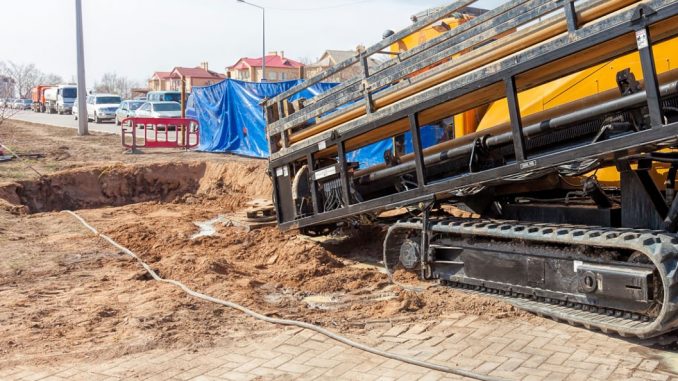
Horizontal directional digging is one of the most popular forms of trenchless pipe installation thanks to its accuracy, versatility and ability to install pipes of various materials and sizes.
Lengthy sections of connected pipework can be installed using horizontal directional digging (HDD) with minimal surface disruption. Pipelines can pass under roads, railways, rivers and buildings without the need to scar the land by digging trenches.
HDD involves a three-stage process which can be carried out by a relatively small crew. The first stage involves drilling a borehole along a pre-determined path from the surface.
This borehole is then enlarged using a reamer and specialist fluids. The reamer rotates through the borehole, cutting away soil. The fluid helps to lubricate and remove soil from the pipe.
Once the borehole has been made large enough to contain the pipe, the pipe is then dragged into the hole. It lies inside, forming a brand new underground pipeline.
That is how HDD works. But what the benefits of installing a pipe using horizontal directional digging?
Extended lifespan of pipelines
Horizontal directional digging extends the lifespan of pipes in two ways. Pipes installed underground are better protected from elements they would otherwise be exposed to if they were aboveground.
Take a pipe bridge for example. A pipeline carried over a river or road is far more likely to suffer corrosion and other types of external damage, requiring either a pipe bridge repair or full replacement of the line.
Lines buried underneath natural and man-made obstacles – which would otherwise be impassable without HDD – have improved durability as they are cocooned underground.
Pipes which undergo installation via HDD are also more robust than normal lines. HDD is an intense process which can cause external damage and scarring when the pipe is dragged through the borehole.
Lines are therefore reinforced with epoxy coatings, shrink sleeves and specialist pipe and weld protection composite wraps. These additional protection measures strengthen pipelines, making them less susceptible to failure and providing them with longer lifespans.
Quicker installation of pipes
When time is of the essence, horizontal directional digging enables pipelines to be laid more quickly than both traditional methods involving trenching and other forms of trenchless pipe installation.
Carving trenches over areas of land, laying pipes and then reburying them is extremely time consuming – especially if pipelines have to take a convoluted route to avoid disruption to existing infrastructure.
Most other forms of trenchless installation involve digging two shafts and then connecting them via a tunnel. HDD reduces the work load by drilling horizontally direct from the surface.
Less drilling mean less soil displaced and less time needed disposing of the dug material – often the most lengthy process when it comes to installing underground pipelines.
Less surface disruption
Faster installation means less surface disruption. Whether a major gas pipeline is being built to improve energy security for a national power supply system or a new water main needs to pass beneath Mrs Jones’ cottage, pipe installations can be disruptive when done via trenching.
Countryside, fields and gardens have to be dug up which can leave behind ugly landscaping. In cities and towns, tearing up roads and streets disrupts everyday life aboveground.
Horizontal directional digging avoids all that with just one dig down at the start of the line. Business continues as normal whilst pipelines are installed.
Reduced chance of damaging existing utilities and infrastructure
One major cause of damage to existing utilities like water networks, gas lines and power cables is accidental drilling. Contractors are not always aware of what is running beneath their feet when they start digging down.
Before they know it, they drill through a waterline and hundreds of litres of water start escaping through a highly pressurised leak.
That risk is severely reduced with horizontal directional digging. HDD installs pipelines accurately on a chartered course through the ground.
In most instances, this will involve passing underneath existing installations – rather than mistakenly attempting to go through them.
More cost-effective than other types of pipeline installation
If the decision on how to install a new pipeline comes down to cost, then horizontal directional digging pushes itself to the front of the queue.
It saves money on manpower, only requiring a small team of operatives compared to bigger digging projects. There is less equipment needed with only one entrance hole drilled compared to the array of tools required to create trenches, shafts and tunnels.
Installation speed also ties into costs. The quicker a project is finished, the less money needs to be spent on it. We already mentioned the lack of displaced soil to be dealt with through HDD and that too brings costs down.
Horizontal directional digging is more cost-effective, straightforward and less disruptive than most other types of pipeline construction. It is no wonder it is one of the most popular installation methods in the world today.

Leave a Reply